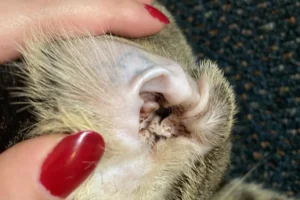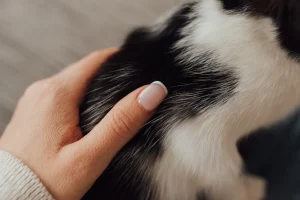As a cat owner, you may have noticed an unexpected issue with your feline friend – dandruff on their tail. Why does this happen, and what can you do to help alleviate it? In this blog post, we will explore the reasons behind your cat’s dandruff on their tail and provide helpful tips to address this common issue.
Understanding Cat Dandruff
If you’ve noticed dandruff on your cat’s tail, several factors could be at play. Dry skin is a common culprit, especially in dry climates or with indoor heating. Additionally, parasites such as fleas or mites can irritate your cat’s skin, leading to dandruff. Lastly, underlying health conditions like allergies or hormonal imbalances could also be the cause.
Regular grooming is essential to help reduce dandruff and improve your cat’s skin and coat health. Brushing your cat regularly helps distribute natural oils, preventing dry skin. Moisturizing shampoos specifically designed for cats can also help hydrate their skin. Additionally, ensuring your cat has a healthy diet rich in omega-3 fatty acids can improve skin health from the inside out.
Grooming Tips for Your Cat
When it comes to grooming your cat, it’s essential to be gentle and patient. Use a soft-bristle brush to gently remove dandruff and distribute oils throughout their coat. Pay special attention to areas like the tail where dandruff may be more noticeable. If your cat has long hair, consider trimming it to prevent mats that can irritate their skin.
In addition to regular brushing, bathe your cat occasionally to remove excess oils and dandruff. Use lukewarm water and a cat-friendly shampoo, being careful to avoid their eyes and ears. After bathing, make sure to thoroughly dry your cat to prevent further skin irritation.
By incorporating these grooming tips into your cat’s routine, you can help reduce dandruff on their tail and improve their overall skin and coat health.
Extra Tip: Regular veterinary check-ups are crucial to identify any underlying health issues that may be contributing to your cat’s dandruff. If you notice persistent dandruff or other skin issues, consult your veterinarian for proper diagnosis and treatment.
Dietary Considerations
Maintaining a balanced diet is key to your cat’s overall health, including the condition of their skin and coat. Make sure your feline friend is getting enough essential fatty acids like Omega-3 and Omega-6, which help keep their skin moisturized and prevent dryness that can lead to dandruff. Look for high-quality cat food that lists meat as the main ingredient, avoiding fillers and artificial additives that can negatively impact your cat’s skin.
In addition to fatty acids, vitamins A and E are also crucial for skin health. These vitamins help maintain the skin barrier function and promote healing. Including foods rich in these vitamins, such as liver and green leafy vegetables, can contribute to a healthier coat for your cat. Remember, a healthy skin starts from within, so feed your cat a nutritious diet to combat dandruff on their tail.
Hydration and Skin Health
Proper hydration is essential for your cat’s skin health, as dehydration can exacerbate dry skin and dandruff issues. Ensure your cat always has access to fresh, clean water throughout the day to encourage regular drinking. You can also incorporate wet food into their diet, which can help increase their overall water intake.
To make hydration fun for your cat, consider investing in a cat fountain or adding a few ice cubes to their water bowl. Some cats prefer running water or cooler temperatures, and these simple changes can encourage them to drink more water. By keeping your cat hydrated, you’re helping their skin stay moisturized and reducing the likelihood of dandruff on their tail.
Extra tip: Brushing your cat regularly not only helps distribute natural oils on their skin but also stimulates blood flow, which can improve overall skin health and reduce dandruff. Consider making brushing sessions a part of your cat’s routine to keep their skin and coat in top condition.
Regular Vet Check-ups
Regular vet check-ups are crucial in identifying and addressing any underlying health issues that may be causing dandruff on your cat’s tail. Your veterinarian can help determine if there are any medical reasons behind the dandruff, such as allergies, parasites, or skin infections. Additionally, they can recommend the best course of action to treat and manage your cat’s condition effectively. Remember, prevention is key, so don’t skip those routine check-ups!
Environmental Factors
Creating an optimal environment for your cat can significantly impact their skin health and reduce dandruff on their tail. Ensure that your home is at a comfortable temperature, not too dry or too humid, as extreme conditions can exacerbate skin issues. Providing a balanced diet rich in essential fatty acids can also help keep your cat’s skin moisturized and healthy. Regular grooming, including brushing your cat’s fur to distribute natural oils, can further prevent dandruff buildup. Remember, a happy and healthy cat starts with a cat-friendly environment!
Tips for Creating an Optimal Environment:
- Maintain a consistent temperature in your home, ideally between 75-80 degrees Fahrenheit.
- Invest in a good quality humidifier to ensure optimal humidity levels between 45-55%.
- Use a high-quality, balanced diet rich in omega-3 and omega-6 fatty acids to promote healthy skin.
- Regularly groom your cat to distribute natural oils and prevent dandruff buildup on their tail.
- Provide plenty of fresh water to keep your cat hydrated and help maintain their skin’s moisture balance.
By paying attention to your cat’s environment and implementing these tips, you can help alleviate and prevent dandruff on their tail, keeping your feline friend comfortable and healthy.
Stress and Dandruff
Does your cat have dandruff on its tail? Stress might be the culprit! Just like humans, cats can experience stress, which can affect their skin health and lead to dandruff. Make sure your feline friend has a calm and peaceful environment to reduce stress levels. Provide cozy hiding spots, interactive toys, and plenty of love and attention to help your cat feel secure and relaxed. Spending quality time with your pet and establishing a routine can also help alleviate stress and promote healthy skin.
Natural Remedies for Cat Dandruff
Nobody likes seeing their pet uncomfortable with dandruff on their tail. Fortunately, there are natural remedies you can try at home. One effective solution is adding a fish oil supplement to your cat’s diet. The omega-3 fatty acids in fish oil can help improve skin health and reduce dandruff. Another option is gently brushing your cat’s coat regularly to remove excess skin flakes and distribute natural oils. Additionally, consider using a moisturizing shampoo specifically designed for cats to help hydrate their skin and alleviate dandruff. Remember to consult your veterinarian before trying any new treatments to ensure they are safe and suitable for your furry friend.
- Incorporate fish oil supplements into your cat’s diet
- Regularly brush your cat’s coat to remove skin flakes
- Use a moisturizing shampoo made for cats
- Consult your vet before trying new treatments
By addressing stress factors and exploring natural remedies, you can help your cat say goodbye to dandruff on its tail and enjoy healthy, shiny skin once again.
Interesting Fact: Cat Dandruff vs. Cat Dander
Did you know that cat dandruff and cat dander are not the same thing? While cat dandruff refers to the dry, flaky skin that can be seen on your cat’s fur or bedding, cat dander actually refers to tiny flecks of skin that can trigger allergies in humans. So, if you notice dandruff on your cat’s tail, it may be a sign of dry skin, while cat dander is more about potential allergy triggers for us humans.
If your cat’s tail is particularly prone to dandruff, it could be due to a few reasons. One common cause is a lack of grooming. Cats are meticulous groomers, but sometimes they may not be able to reach certain parts of their bodies adequately, leading to dandruff buildup, especially on their tail. Additionally, your cat’s diet can also play a role in the health of their skin and fur. Make sure your furry friend is getting a well-balanced diet with essential nutrients to keep their skin healthy and moisturized.
Remember, if your cat has dandruff on their tail, it’s essential to address the underlying cause. Regular grooming, a balanced diet, and consulting with your vet can help keep your cat’s skin healthy and dandruff-free.
Additional Tip: Use a soft brush to gently groom your cat’s tail and distribute natural oils, helping to prevent dandruff buildup.
Alex, a passionate animal lover, has experience in training and understanding animal behavior. As a proud pet parent to two dogs and three cats, he founded AnimalReport.net to share insights from animal experts and expand his knowledge of the animal kingdom.




